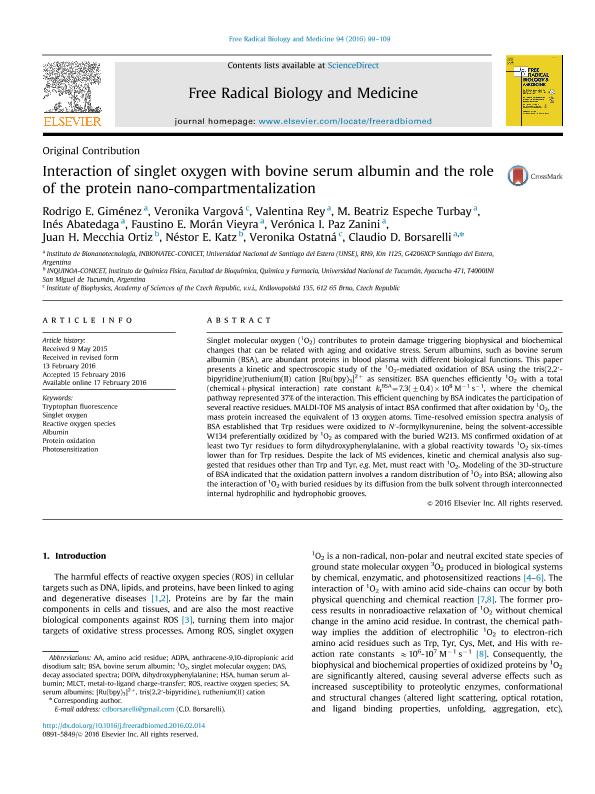Mostrar el registro sencillo del ítem
dc.contributor.author
Gimenez, Rodrigo Esteban

dc.contributor.author
Vargová, Veronika
dc.contributor.author
Rey, Valentina

dc.contributor.author
Espeche Turbay, Maria Beatriz

dc.contributor.author
Abatedaga, Maria Ines de Los Angeles

dc.contributor.author
Moran Vieyra, Faustino Eduardo

dc.contributor.author
Paz Zanini, Veronica Irene

dc.contributor.author
Mecchia Ortiz, Juan Hugo

dc.contributor.author
Katz, Néstor Eduardo

dc.contributor.author
Ostatná, Veronika
dc.contributor.author
Borsarelli, Claudio Darío

dc.date.available
2018-03-12T20:27:48Z
dc.date.issued
2016-05
dc.identifier.citation
Gimenez, Rodrigo Esteban; Vargová, Veronika; Rey, Valentina; Espeche Turbay, Maria Beatriz; Abatedaga, Maria Ines de Los Angeles; et al.; Interaction of singlet oxygen with bovine serum albumin and the role of the protein nano-compartmentalization; Elsevier Science Inc; Free Radical Biology and Medicine; 94; 5-2016; 99-109
dc.identifier.issn
0891-5849
dc.identifier.uri
http://hdl.handle.net/11336/38595
dc.description.abstract
Singlet molecular oxygen (1O2) contributes to protein damage triggering biophysical and biochemical changes that can be related with aging and oxidative stress. Serum albumins, such as bovine serum albumin (BSA), are abundant proteins in blood plasma with different biological functions. This paper presents a kinetic and spectroscopic study of the 1O2-mediated oxidation of BSA using the tris(2,2′-bipyridine)ruthenium(II) cation [Ru(bpy)3]2+ as sensitizer. BSA quenches efficiently 1O2 with a total (chemical+physical interaction) rate constant ktBSA=7.3(±0.4)×108 M-1 s-1, where the chemical pathway represented 37% of the interaction. This efficient quenching by BSA indicates the participation of several reactive residues. MALDI-TOF MS analysis of intact BSA confirmed that after oxidation by 1O2, the mass protein increased the equivalent of 13 oxygen atoms. Time-resolved emission spectra analysis of BSA established that Trp residues were oxidized to N′-formylkynurenine, being the solvent-accessible W134 preferentially oxidized by 1O2 as compared with the buried W213. MS confirmed oxidation of at least two Tyr residues to form dihydroxyphenylalanine, with a global reactivity towards 1O2 six-times lower than for Trp residues. Despite the lack of MS evidences, kinetic and chemical analysis also suggested that residues other than Trp and Tyr, e.g. Met, must react with 1O2. Modeling of the 3D-structure of BSA indicated that the oxidation pattern involves a random distribution of 1O2 into BSA; allowing also the interaction of 1O2 with buried residues by its diffusion from the bulk solvent through interconnected internal hydrophilic and hydrophobic grooves.
dc.format
application/pdf
dc.language.iso
eng
dc.publisher
Elsevier Science Inc

dc.rights
info:eu-repo/semantics/openAccess
dc.rights.uri
https://creativecommons.org/licenses/by-nc-sa/2.5/ar/
dc.subject
Albumin
dc.subject
Photosensitization
dc.subject
Protein Oxidation
dc.subject
Reactive Oxygen Species
dc.subject
Singlet Oxygen
dc.subject
Tryptophan Fluorescence
dc.subject.classification
Otras Ciencias Químicas

dc.subject.classification
Ciencias Químicas

dc.subject.classification
CIENCIAS NATURALES Y EXACTAS

dc.title
Interaction of singlet oxygen with bovine serum albumin and the role of the protein nano-compartmentalization
dc.type
info:eu-repo/semantics/article
dc.type
info:ar-repo/semantics/artículo
dc.type
info:eu-repo/semantics/publishedVersion
dc.date.updated
2018-03-12T18:32:29Z
dc.journal.volume
94
dc.journal.pagination
99-109
dc.journal.pais
Estados Unidos

dc.journal.ciudad
Amsterdam
dc.description.fil
Fil: Gimenez, Rodrigo Esteban. Universidad Nacional de Santiago del Estero. Instituto de Bionanotecnología del Noa. Consejo Nacional de Investigaciones Científicas y Técnicas. Centro Científico Tecnológico Conicet - Tucumán. Instituto de Bionanotecnología del Noa; Argentina
dc.description.fil
Fil: Vargová, Veronika. Institute Of Biophysics Of The Academy Of Sciences Of The Czech Republic; República Checa
dc.description.fil
Fil: Rey, Valentina. Universidad Nacional de Santiago del Estero. Instituto de Bionanotecnología del Noa. Consejo Nacional de Investigaciones Científicas y Técnicas. Centro Científico Tecnológico Conicet - Tucumán. Instituto de Bionanotecnología del Noa; Argentina
dc.description.fil
Fil: Espeche Turbay, Maria Beatriz. Universidad Nacional de Santiago del Estero. Instituto de Bionanotecnología del Noa. Consejo Nacional de Investigaciones Científicas y Técnicas. Centro Científico Tecnológico Conicet - Tucumán. Instituto de Bionanotecnología del Noa; Argentina
dc.description.fil
Fil: Abatedaga, Maria Ines de Los Angeles. Universidad Nacional de Santiago del Estero. Instituto de Bionanotecnología del Noa. Consejo Nacional de Investigaciones Científicas y Técnicas. Centro Científico Tecnológico Conicet - Tucumán. Instituto de Bionanotecnología del Noa; Argentina
dc.description.fil
Fil: Moran Vieyra, Faustino Eduardo. Universidad Nacional de Santiago del Estero. Instituto de Bionanotecnología del Noa. Consejo Nacional de Investigaciones Científicas y Técnicas. Centro Científico Tecnológico Conicet - Tucumán. Instituto de Bionanotecnología del Noa; Argentina
dc.description.fil
Fil: Paz Zanini, Veronica Irene. Universidad Nacional de Santiago del Estero. Instituto de Bionanotecnología del Noa. Consejo Nacional de Investigaciones Científicas y Técnicas. Centro Científico Tecnológico Conicet - Tucumán. Instituto de Bionanotecnología del Noa; Argentina
dc.description.fil
Fil: Mecchia Ortiz, Juan Hugo. Consejo Nacional de Investigaciones Científicas y Técnicas. Centro Científico Tecnológico Conicet - Tucumán. Instituto de Química del Noroeste. Universidad Nacional de Tucumán. Facultad de Bioquímica, Química y Farmacia. Instituto de Química del Noroeste; Argentina
dc.description.fil
Fil: Katz, Néstor Eduardo. Consejo Nacional de Investigaciones Científicas y Técnicas. Centro Científico Tecnológico Conicet - Tucumán. Instituto de Química del Noroeste. Universidad Nacional de Tucumán. Facultad de Bioquímica, Química y Farmacia. Instituto de Química del Noroeste; Argentina
dc.description.fil
Fil: Ostatná, Veronika. Institute Of Biophysics Of The Academy Of Sciences Of The Czech Republic; República Checa
dc.description.fil
Fil: Borsarelli, Claudio Darío. Universidad Nacional de Santiago del Estero. Instituto de Bionanotecnología del Noa. Consejo Nacional de Investigaciones Científicas y Técnicas. Centro Científico Tecnológico Conicet - Tucumán. Instituto de Bionanotecnología del Noa; Argentina
dc.journal.title
Free Radical Biology and Medicine

dc.relation.alternativeid
info:eu-repo/semantics/altIdentifier/url/https://www.sciencedirect.com/science/article/pii/S0891584916000654
dc.relation.alternativeid
info:eu-repo/semantics/altIdentifier/doi/http://dx.doi.org/10.1016/j.freeradbiomed.2016.02.014
Archivos asociados
